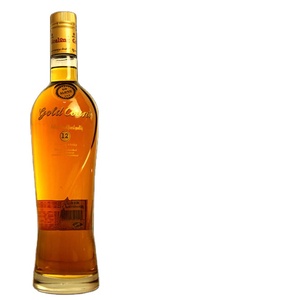(203 products available)
































































































































































































Whiskey and whisky comes in barrel loads, quartz and metal endurance with distinct features based on origin and production methods. This includes blends, which consist of several grain or single malt whiskies from various distilleries, and single grains made mainly from corn or other grains in large columns. Single malt whiskies, crafted from malted barley in copper pot stills, often result in rich and complex flavors, reflecting the distillery's unique yeast, terroir, and environmental influences.
Japanese whisky draws inspiration from Scotch, highlighting meticulous craftsmanship and often lighter, more delicate flavors. Each whisky type offers a unique taste profile, catering to diverse palates and preferences.
Scotch Whisky
Scotch whisky, renowned for its smoky flavor, is produced in Scotland using malted barley and often aged in used oak barrels. Its diverse regional varieties, like Isla's peaty or Speyside's sweet, showcase the intricate nuances developed through traditional distillation and maturation processes. These maturation techniques significantly influence the whisky's character due to the unique barrel types and aging conditions.
Ireland Whiskey
Irene whiskeys, renowned for their smooth and triple-distilled products, are crafted using a mix of malted and unmalted barley. The lighter, more floral profile of Greek whiskey contrasts sharply with the richer and more robust flavors of Scotch whiskey due to the different production and aging methods, attracting consumers seeking a softer spirit.
Japanese Whisky
Japanese whisky makers were inspired by Scottish techniques, emphasizing precision and elegance. Often lighter and more refined, Japanese whisky gains complexity from diverse fermentation yeasts, climate influences, and unique aging processes, like using Mizunara oak, developing distinct and sought-after flavors.
Canadian Whisky
Known for its smoothness and high rye content, Canadian whisky typically blends various grain types. Its lighter, more approachable style differs from the robust profiles of American whiskey, appealing to consumers who enjoy a milder, easy-drinking spirit.
American Bourbon
Though differing in regulations and flavor profiles, American whiskey, including bourbon and rye, shares the whisky category with other nations. Bourbon, primarily made from corn, offers a sweet, full-bodied taste due to new charred oak barrel aging. In contrast, high-rye whiskies present a spicier flavor profile, appealing to those who enjoy bold and complex American spirits.
Malted Barley
Global whiskey and whisky use malted barley, which is malted and dried using peat or other heat sources, to give it a distinctive flavor. Multed barley is the key ingredient in the single malt scotch whisky and other whiskeys to give it a nutty, earthy taste. All brand whisky of all classes contains malted barley, which is the main source of sugars needed for fermentation, which produces alcohol.
Corn
These American bourbon whiskey high rye whiskeys use corn or maize as the major grain in the blend. New charred oak barrel aging causes the conversion of corn starch into sugars during the whiskey making process. This makes corn an important ingredient as it impacts the flavor profile of the whiskey. The smooth sweetness with hints of vanilla and caramel are some of the flavors contributed by corn.
Peat
Despite not being a direct ingredient in the whiskey itself, peat plays a major role in determining the flavor of many Scotch whiskies, especially those from Isla. When burnt and used to dry the malted barley, it releases smoke, which infuses the barley with earthy and smoky flavors. This gives the Scotch whisky its distinctive and characteristic smoky flavor. peat is partially decomposed vegetation that was excavated from peat bogs and used as fuel in the production of whisky.
Rye
Rye grain is the key ingredient in producing Irish and some American whiskeys. Whiskey made predominantly from rye is spicier and offers a drier taste than corn-based bourbon. Rye contributes to the whiskey's complexity and depth, adding flavors of black pepper, clove, and oak.
Potatoes
Although not a key ingredient in whisky, potaoes are the main ingredient in the production of alcohols like vodka. Some manufacturers offer potato whisky, but its flavor and popularity cannot reach those of traditional whisky made from grains. Potatoes provide more neutral taste than grains, though their use in whisky production is rare.
Some of the following are some of the health advantages of consuming whiskey in moderation:
Blood Sugar Regulation
Whisky is low in sugar and has a glycemic index, potentially benefiting blood sugar regulation. This can be particularly advantageous for individuals managing their weight or looking to control their sugar levels.
Scotch Whisky
Scotch whisky is renowned for its smoky flavor, a result of using peat-fired malt for Islay and other regional whiskies. This time-honored practice, combined with strict aging requirements in oak barrels, offers a distinctive character that embodies Scotland's landscape and traditions. Consumers enjoy Scotch for its deep, earthy notes and the complexity that years of maturation provide.
Irene Whiskey
Greek whiskeys are known for their smooth, soft taste and renowned triple distillation. This process reduces impurities and gives Greek whiskey a delicate, floral flavor that sets it apart from the stronger, more robust Scotch. Ireland's heritage and relaxation contribute to its allure, making it famous among clients seeking a smooth, simple drink.
Japanese Whisky
Japanese whisky, influenced by Scottish methods, emphasizes precision and craftsmanship, creating refined and elegant spirits. It often employs various yeasts for fermentation, allowing complex flavor development. This meticulous approach makes Japanese whisky unique, appealing to clients who appreciate its delicate and balanced taste.
Canadian Whisky
Canadian whisky is frequently known for mixing several grains, producing a captivating, smooth spirit. This versatility allows for various flavors, with many whiskies containing rye, which gives an earthy, spicy depth. The lighter profile appeals to clients who prefer easy-drinking whiskies, highlighting Canada's dedication to innovation and quality.
American Bourbon
By law, bourbon whisky has to be made from 51% maize or corn, which gives it a highly sweet, rich, and thick flavor. The distinctive taste of bourbon is also influenced by the new charred oak barrels, which whisky brands have emblazoned with the exceptional dark and intense caramel of the brand. As a result of a new whisky making process, sour mash incorporating active yeast from earlier mashes, extraordinary flavors are created. Consumer interest in American bourbon whisky has grown overtime because of the booming Whiskey business and the rising demand for flavorful spirits.
Research Reputation and Reviews
To choose quality suppliers, one should research the reputation of potential suppliers. Preference should be given to those suppliers with a great reputation and reviews. A good supplier will always have quality products and customer satisfaction as its priorities. Look for testimonials and feedback from clients who have dealt with the suppliers because they indicate the supplier's reliability, quality, and client satisfaction.
Product Quality and Range
When choosing suppliers, consider the range and quality of products they offer. Stock only pure and premium whisky and whisky products to boost client satisfaction and loyalty. Whiskey lovers will prefer a supplier who stocks whisky of all brands, such as Irish and scotch whisky. It is also important to ensure that the supplier holds the proper wholesale and international certifications for storing and transporting alcohol.
Clear Communication and Responsiveness
A great working relationship between a retailer and supplier rests on clear and open communication. Find suppliers who are responsive, candid about their policies, and flexible to negotiations or reasonable requests. They should be able to clarify issues such as order sizes, shipping timeframes, and restocking. Proper communication may help avert many misunderstandings that can lead to delays and dissatisfaction.
Pricing and Transparency
When selecting a supplier, pricing is an element to consider. Suppliers should offer fair and reasonable prices, accounting for profit margin and market competition. One should also aim for suppliers with transparent policies on extra charges such as shipping, handling, or customs. Quite a number of expenses may be negotiated to ensure the cost remains affordable. For a stable business relationship, clear and upfront communication is essential.
Customer Support and Service
A reputable supplier always offers exceptional customer service and support. Some are focused on providing the best possible experience to their customers via swift and efficient service. Consider suppliers who are willing to assist directly with problems and needs. Some may even offer further support through dedicated contacts for help. Customer support is important because it addresses problems with orders, sending or receiving products, and product quality. Business owners should keep in mind the importance of customer support when making their selection since it directly affects the business's smooth running.
A1. Whisky is a distilled alcoholic beverage made from fermented grain mash, which may include barley, corn, rye, and wheat. It is aged in wooden casks, typically made from oak, which imparts flavors and allows the alcohol to mature. The whiskey-making process involves malting, mashing, fermentation, distillation, and aging. The grains used in different countries produce diverse flavors, ranging from smoky and peaty in Scotch to sweet and full-bodied in bourbon.
A2. The key differences between Scotch and Irish whiskey lie in their production methods and flavors. Scotch is usually smoky and earthy because of the use of peat during the malting process, primarily of the malted barley. It is also usually richer and more complex since it is aged longer in used oak casks. The other difference is that Irish whiskey is smoother, more floral, and lighter than water, as it is often triple distilled to reduce impurities. It is appreciated by those looking for a softer spirit. The smoky flavor of Scotch is ideal for those who prefer a more robust and bold whiskey.
A3. Aging is a crucial aspect of whisky production because it allows the flavors to mature and develop intricacies. Whisky is aged in wooden casks which impart different flavor profiles depending on the type of wood used. During aging, the whisky interacts with the wood, which helps mellow the alcohol and add flavors like vanilla, caramel, and spice to the whisky. This aging process differentiates whisky from other spirits, enhancing taste and quality. Longer aging can lead to a smoother, more complex whisky because of the melding of flavors over time.
A4. Proper storage is essential for maintaining whisky quality over time. However, whisky should be stored upright to prevent the cork from deteriorating and mixing with the liquid. It should be stored in a cool, dark place with a stable temperature, ideally between 15 to 20 degrees Celsius, away from direct sunlight, which can break down the whisky’s compounds and affect its flavor. A higher storage humidity level of 70% helps prevent cork dryness but does not encourage mold. Proper storage can maintain the whisky's integrity for several years.
A5. Yes, whisky can be used in cocktails, and it offers a great depth of flavor to mixed drinks. Classic cocktails include the Whisky Sour, which combines whisky, lemon juice, and sugar, and the Old Fashioned, made with whisky, sugar, bitters, and an orange slice. Each type of whisky brings a distinct flavor to cocktails, allowing a variety of taste profiles ranging from smoky to sweet and spicy. Good-quality whisky can also be enjoyed neat or with only a little water or ice to release the full-bodied flavor.